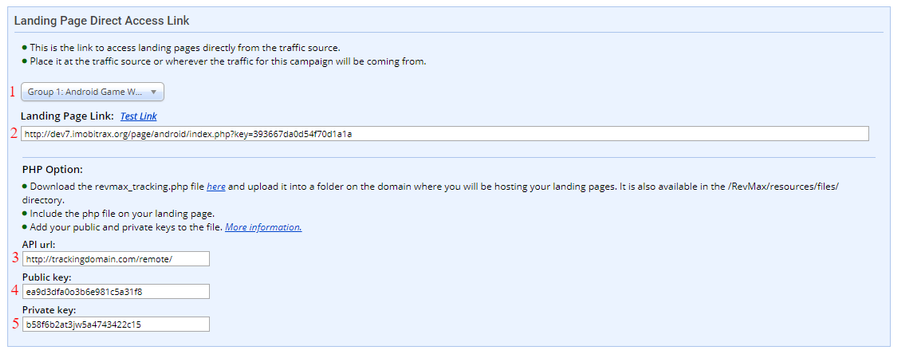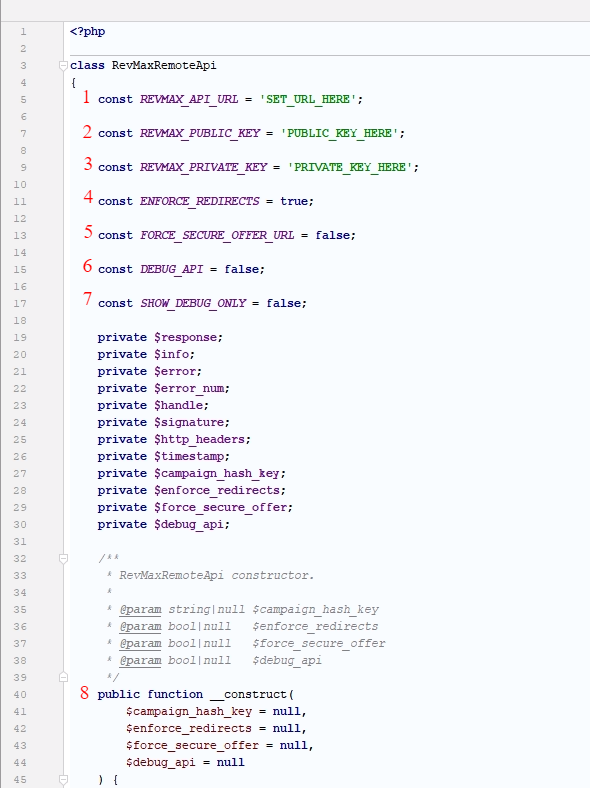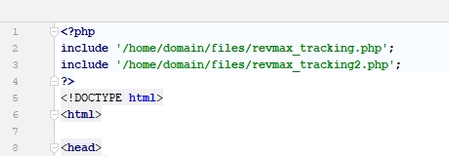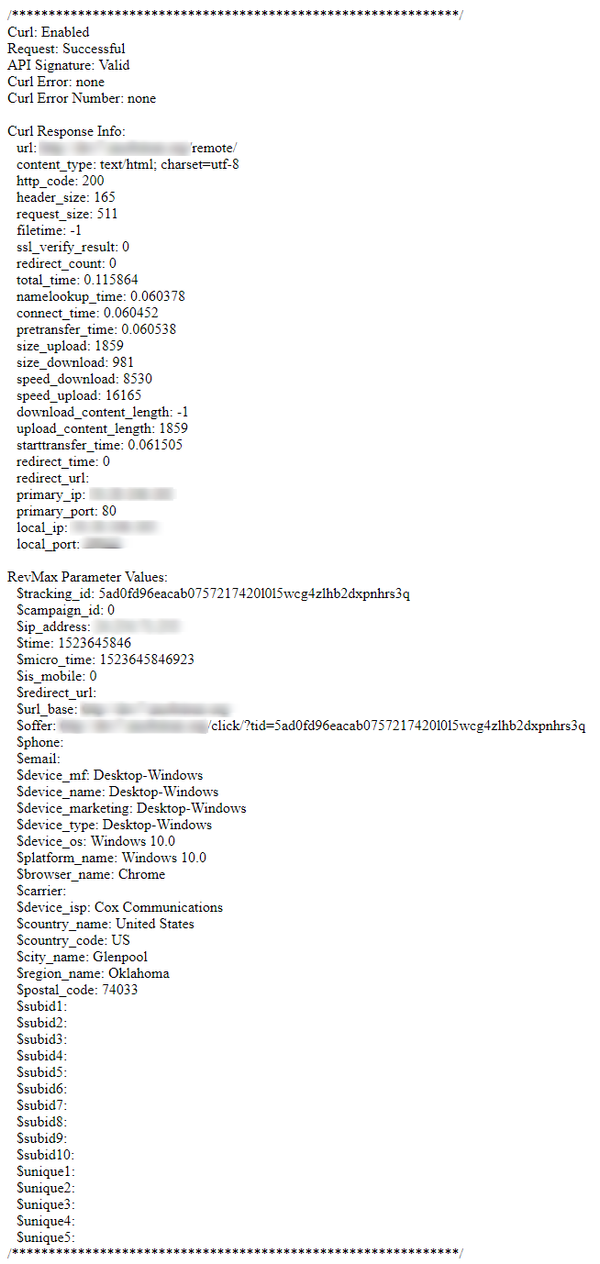Direct Access Landing Page Tracking
RevMax can be set up to allow direct access to landing pages originating from paid sources or organic traffic.
General Guidelines and Info
- Landing pages must be php. Why? By utilizing php and cURL calls, display variables and offer links are easily generated and used. As well, the cURL call bypasses any browser blocking capabilities, and allow more accurate traffic detection.
- cURL must be enabled on the server where the landing page resides. cURL is generally enabled by default. It can be checked using the debug option discussed later if issues arise.
- It is best to keep 1 copy of the tracking file for any given server, or domain, if applicable. This will make any update to the file easier, as no one wants to replace 100 files.
- RevMax uses url detection to determine the landing page. Therefore, try not to duplicate landing pages in any given campaign.
- If possible, place tracking file outside of the public directory. Depending on server setup, this can also make 1 file accessible by different domains.
- Do not use this option if redirect rules are utilized to direct traffic to other campaigns or landing pages on inbound clicks. Outbound rules, offer rotation, etc can still be used.
Quick Start
- Navigate to the tracking tab of the landing page campaign, and scroll to the "Landing Page Direct Access Link" section.
- If not done previously, download or acquire from the resource directory the revmax_tracking.php file.
- Select the landing page from the dropdown. A direct access campaign link to the landing page will then display in the text box below.
- Edit the file and set the REVMAX_API_URL, REVMAX_PUBLIC_KEY and REVMAX_PRIVATE_KEY in the file. These settings will not change.
- Upload the file to the server/domain where the landing page is located.
- Include the file at the top of the landing page using an absolute path.
- Set any offer or desired variables on the page using php code. See Generated Variables below.
- Place the direct access campaign link at the traffic source, or utilize same to access the page.
- Verify offer links are populated and working.
GUI Options
- Drop down for selecting the landing page.
- Upon selection of a landing page, the direct access link will be generated and populated here.
- API Url → add to tracking file
- Public key → add to tracking file
- Private key → add to tracking file
File Settings and Options
- const REVMAX_API_URL = 'SET_URL_HERE'; → SET_URL_HERE needs to be replaced by the full API generated in the "Landing Page Direct Access Link" section.
- const REVMAX_PUBLIC_KEY = 'PUBLIC_KEY_HERE'; → PUBLIC_KEY_HERE needs to be replaced by the Public key generated in the "Landing Page Direct Access Link" section.
- const REVMAX_PRIVATE_KEY = 'PRIVATE_KEY_HERE'; → PRIVATE_KEY_HERE needs to be replaced by the Private key generated in the "Landing Page Direct Access Link" section.
- const ENFORCE_REDIRECTS = true; → If true, redirects to urls or blank pages set for Bot Redirect URLs or Filter Override URLs will occur.
- const FORCE_SECURE_OFFER_URL = false; → if true, links to offers from the landing page to the tracking domain will utilize ssl, regardless if they were set that way in offer setup.
- const DEBUG_API = false; → if true, debug information will be displayed on the landing page showing cURL call and response data, and RevMax variables/values available for use on the landing page.
- const SHOW_DEBUG_ONLY = false; → If true, only debug information will display on the landing page when DEBUG_API is set to true.
- Constroctor arguments to override default constant settings.
Generated Variables
- $offer
- $offer1 → $offer25
- $tracking_id
- $ip_address
- $time
- $micro_time
- $is_mobile
- $redirect_url
- $url_base
- $offer
- $phone
- $device_mf
- $device_name
- $device_marketing
- $device_type
- $device_os
- $platform_name
- $browser_name
- $carrier
- $device_isp
- $country_name
- $country_code
- $city_name
- $region_name
- $postal_code
- $subid1
- $subid2
- $subid3
- $subid4
- $subid5
- $subid6
- $subid7
- $subid8
- $subid9
- $subid10
- $unique1
- $unique2
- $unique3
- $unique4
$unique5
Usage and Techniques
Basic
Generally, uploading the tracking file and including it in all applicable landing pages will work for most users. This provides a common file and easy changes or updates.
Advanced
The tracking file is comprised of 2 "sections". The first section is the class used to make the API call and process variables (inbound and outbound.) The 2nd section is the php code that initiates the class, makes appropriate method calls, and generates the php variables for use on landing pages. This can be seen below.
In some cases, it may be desirable to seperate the 2 sections into 2 seperate files and include each on the landing page.
Expanding, it is also possible to remove the 2nd include and place the 2nd section code directly on the landing page below the first include.
As arguments can be passed to the class constructor and override the class constants, using this technique can allow different arguments for different pages, while keeping code duplication to a minimum.
Situations for using the above might be debuging 1 landing page, while not affecting others, different campaign hashes and options for different campaigns, etc.
Tracking Organic Traffic
To track organic traffic, set up the landing page as described in the Usage and Techniques -> Advanced section above. Then, add your campaign hash into the constructor as shown below;
Both paid and organic traffic to this landing page will now be tracked.
Security
The following are the primary techniques used for securing the API.
- The direct access API utilizes public and private keys for validation.
- Data is encrypted during transmission.
- Time, and some other data, are used to validate API requests.
Troubleshooting
- Check and verify that the REVMAX_API_URL is correct.
- Check and verify that the REVMAX_PUBLIC_KEY is correct.
- Check and verify that the REVMAX_PRIVATE_KEY is correct.
- Set DEBUG_API to true as described above in File Settings and Options.
- If unable to determine, contact support. Please provide the direct acces link in question.






